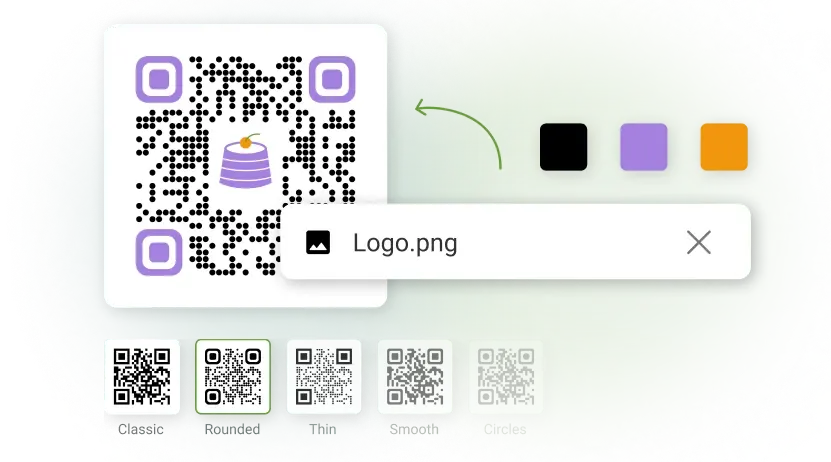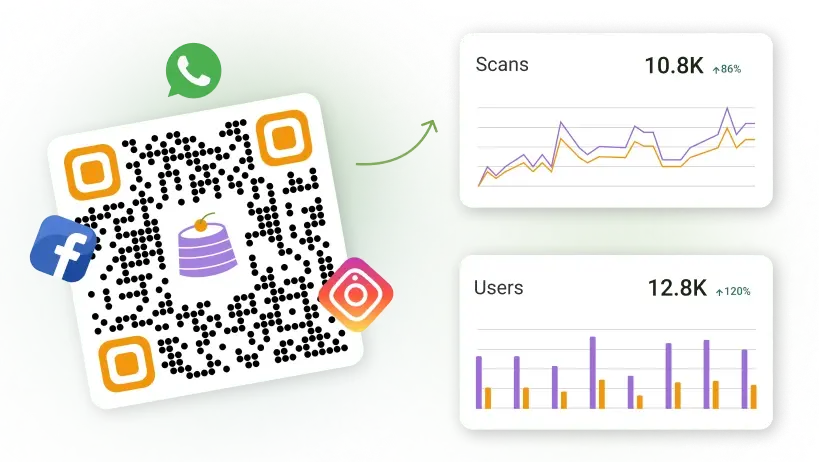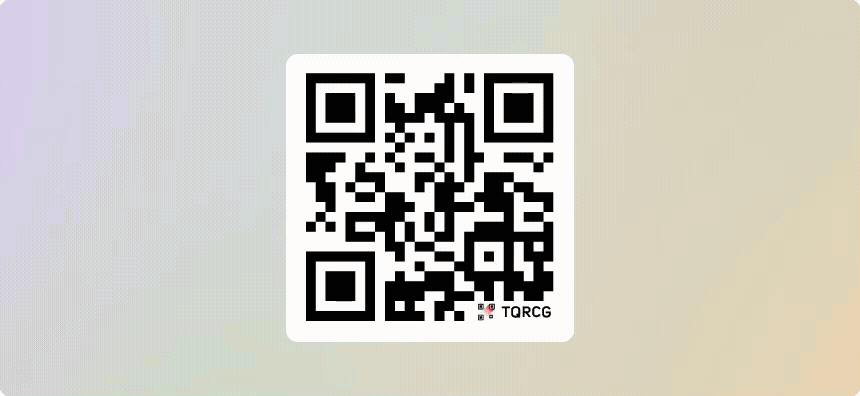Job searching is already challenging, with recruiters spending only an average of 7.4 seconds screening your resume, ATS screening, and hundreds of applications for a single role.
Moreover, one-page resumes make it more challenging to clearly display all your skills and achievements. This means you must find ways to stand out swiftly and effectively. Adding a QR Code to your resume is an innovative solution, directing recruiters to all your achievements with one scan.
In this article, learn how you can strategically use resume QR Codes to get a competitive edge in this job market.
Why traditional resumes limit your job search
The initial screening of your job application is often decided by one piece of paper. It’s challenging to convey everything that makes you a strong candidate in this brief document.
Let’s explore how QR Codes can help you stand out and communicate more effectively during this critical first step.
1. Resumes have limited space
A standard one-page resume fits only about 300 to 400 words. That’s rarely enough to capture your full range of experience, especially if you work in creative or technical fields that require examples of your work. Important achievements or projects often get cut for brevity, making it difficult to present a complete picture of your skills.
2. Hard to show skills and personality
Resumes can list what you’ve done, but they can’t show how you work. Qualities like creativity, communication, or problem-solving rarely come through on paper. This leaves hiring managers with a flat view of your capabilities and personality, especially compared to candidates who already have visible online portfolios or profiles.
3. Impossible to update after submission
Once you send a resume, it’s frozen in time. If you complete a major project, earn a new certification, or take on a leadership role, that progress won’t be reflected in your application. Since hiring processes often take weeks or months, the version recruiters see might already be outdated.
4. No easy way for recruiters to verify claims
A survey found that 70% of workers lie on their resumes, which makes recruiters naturally skeptical of unverified claims. Traditional resumes provide no way to confirm credentials or project results before an interview. As a result, recruiters often turn to Google or LinkedIn for verification, leaving candidates little control over what they find or how they interpret it.
Adding a QR Code to your resume solves all these problems. A quick scan can take hiring teams directly to your online portfolio, LinkedIn profile, or your video introduction. You can update the linked content anytime, keeping your professional story fresh and accurate.
How QR Codes on resumes give job seekers a competitive edge
A job application has an average of 250 applicants, and only five make it to the interview stage. That means your resume has to do more than summarize your work. It needs to capture attention and prove credibility within seconds.
Here’s how adding a QR Code can help you stand out and communicate your value more effectively.
Direct employers to your best work samples
Recruiters want to see real examples of your skills in action. A resume QR Code lets them access your most relevant work instantly, whether that means a live project, a design portfolio, or published writing.
Different fields have their own preferred formats:
- Developers can link to GitHub projects that show technical ability.
- Designers can share visual portfolios on Behance or Dribbble.
- Writers and marketers can point to bylined articles or campaign results.
Instead of listing long URLs or relying on recruiters to search for your work, a QR Code gives them direct access to the proof they need to evaluate your skills quickly.
Connect better with a video introduction
With hiring down 8.7% year over year, job seekers face tougher competition and less recruiter bandwidth. A short 60–90 second video introduction helps hiring managers see who you are beyond your resume. It gives them a quick sense of your communication style, confidence, and enthusiasm.
You can use this short clip to summarize your career focus, highlight a project, or explain how your skills align with a company’s goals. A QR Code linking to your video keeps it professional, accessible, and optional, making it easy to add personality without taking up extra space.
Link to your LinkedIn profile for social proof
Your LinkedIn profile includes recommendations from colleagues, endorsements of your skills, your full career history, and thought leadership through published articles.
When a recruiter scans your LinkedIn QR Code and lands on a polished LinkedIn profile with glowing recommendations and industry articles, they see credibility and depth. Consider whether to use a custom LinkedIn QR Code or LinkedIn’s native code; both work, but custom QR Codes give you more control over branding and analytics.
Showcase all your achievements
If you’ve earned certifications, completed specialized training, given talks, or published work, those credentials matter; however, listing them all can clutter your resume. A QR Code can link to a dedicated page showcasing your qualifications in an organized, easy-to-scan format.
💡 Pro tip: You can use The QR Code Generator (TQRCG) to create a forever-free multi-URL QR Code for your resume. It lets you link all your work, credentials, and introductions in one place and track recruiter engagement as well.
How to create a QR Code for your resume that drives engagement
From content to choosing the type of QR Code, there are some things that you need to know while creating your resume QR Code.
1. Decide what your QR Code should link to
Your QR Code’s destination matters as much as the QR Code itself. The best destination depends on your industry and the impression you want to make.
Avoid linking to generic destinations, such as your company’s homepage, a downloadable PDF, or content behind a login wall. These slow recruiters down and reduce engagement.
2. Use a professional QR Code generator for maximum control
A lot of sites, such as LinkedIn and YouTube, have their own QR Code built in. While convenient, these native QR Codes come with limitations that can impact how effectively you engage recruiters.
Using independent QR Code generators like TQRCG gives you the following advantages:
- Customize QR Code colors, logos, and frames to match your personal brand.
- Access detailed analytics to track scans and engagement
- Update your destination link anytime without changing the QR Code
- Link to multiple types of content, not just a profile page
- Present a polished, branded look that stands out on your resume
You can create a QR Code on your resume easily with TQRCG:
Step 1: Log in and select QR Code type

Sign in to The QR Code Generator (TQRCG) and choose either a URL QR Code (for a single destination like your portfolio or LinkedIn) or a multi-URL QR Code (if you want to showcase multiple links like portfolio, certifications, and videos).
Step 2: Add a title and your destination links

Enter a professional title like “View My Portfolio” or “See My Work” that will appear at the top of your landing page. Then, paste your key links such as your portfolio website, LinkedIn profile, GitHub, Behance, or a short video introduction.
Click Next when done.
Step 3: Customize your resume QR Code design

Make your QR Code visually align with your personal brand. Add your logo, adjust colors to match your resume theme, and choose a clean shape. Include a CTA frame with text like “Scan to view portfolio” to encourage interaction.
💡 Pro tip: Use QR Code frames to brand your QR Code and add a short, actionable text to encourage scans. This way, your QR Code looks professional, saves space, and encourages the recruiter to click.
Step 4: Name, download, and test your QR Code

Give your QR Code a clear name and download it in a high-resolution QR Code format (SVG or PNG) suitable for print and digital resumes. Before using it, test the QR Code on multiple devices to ensure it scans quickly and links correctly.
3. Track scan analytics to understand recruiter interest
One of the biggest advantages of using a professional QR Code generator is trackable QR Codes. You can track:
- Total scans versus applications submitted
- Scan timing (when recruiters engage with your QR Code)
- Geographic location (which markets show interest)
This data reveals a lot. You can A/B test the placement or content of your QR Code to see which one works better and generates the most responses.
4. Decide whether to include QR Codes on digital vs. print resumes
QR Codes work differently depending on how your resume is shared.
Print resumes (at career fairs, networking events, or in-person interviews) are perfect for QR Codes, as scanning feels natural in those contexts.
Digital resumes (submitted via job portals or email) require more thought. For outreach contexts, such as personalized emails or LinkedIn messages, a QR Code can provide an immediate and engaging way for recruiters to access your portfolio or additional work. It’s best to create two versions of your resume. Use your QR Code on PDFs shared via LinkedIn, email, or personal networking. For online job portal submissions, consider removing the QR Code and replacing it with a direct hyperlink to your portfolio, as applicant tracking systems (ATS) might not parse it.
Best practices for using QR Codes on resumes
Here are some tips you need to follow to ensure you stand out from a pool of hundreds of candidates.
Always follow industry design guidelines
When adding a QR Code to your resume, it is important to ensure it does not overpower your resume. Keep your QR Code size at least 0.8 × 0.8 inches, with 1 × 1 inch recommended for most layouts. Never exceed 1.5 × 1.5 inches to ensure your QR Code remains both scan-friendly and visually balanced.
Place the QR Code strategically
Place your QR Code in the header next to your contact information and along the sidebar or margin. You can also choose to place it at the footer to end your resume with proof of work.
Add a clear CTA
Use a concise call to action (CTA) such as “Scan to view portfolio,” or “See my work,”. Put your call-to-action directly below or beside the QR Code, using a smaller font (8–10 pt) in lighter shades for subtlety.
Always use dynamic QR Codes
Use dynamic QR Codes to update or change your landing page link even after you’ve printed or sent your resume. Use scan analytics to see which companies check your resume, when they scan it, and which roles attract the most attention.
After interviews, you can also quickly update your portfolio or featured projects based on the direct feedback you receive.
📝Note: The QR Code Generator (TQRCG) offers two free dynamic QR Codes with scan analytics and unlimited updates, perfect for active job seekers.
Test the resume before sharing
Once you’ve added the QR Code to your resume, test it across devices such as iPhone, Android, and third-party apps. Give it to peers and gather feedback on whether you need to change anything. Also, use tools like Resume Worded or JobScan to understand how ATS is parsing your resume.
💡 Pro tip: Avoid these common pitfalls while creating your resume QR Code
- Never link to outdated or incomplete content; always ensure your online presence is polished and current.
- Don’t generate different QR Codes for every application; tracking can get very complicated.
- Don’t use QR Codes as a crutch for weak resume content; always use them to supplement your resume.
Upgrade your resumes with trackable QR Codes
Traditional resumes just can’t capture all you bring to the table, but QR Codes make it possible. They give you the ability to showcase your skills exactly how you want to. When designed thoughtfully, resume QR Codes put you in the driver’s seat.
Strategically implementing QR Codes by using professional and on-brand designs and opting for dynamic QR Codes gives you control over your narrative and ensures your best qualities get noticed.
Start by creating your trackable, customizable resume QR Code with The QR Code Generator (TQRCG). With two forever-free dynamic QR Codes and detailed analytics, TQRCG helps you not only look professional but also understand how your resume resonates with employers.
Frequently asked questions
Including a QR Code on a resume can make a strong impression, especially in creative, marketing, or tech industries. It’s a great way to lead recruiters to your portfolio, LinkedIn profile, or video introduction. However, in traditional fields such as law or finance, it may appear unconventional. Only include a resume QR Code if it links to content that adds real value to your application.
Yes, many recruiters do scan resume QR Codes when they are clearly labeled and look professional. Scans are most likely when recruiters are already interested in your profile and want to view proof of work or project samples.
No, it won’t. Applicant tracking systems (ATS) primarily read text, so they ignore image elements like QR Codes. To avoid issues, position your QR Code in the header, footer, or margin, not within core text sections. It’s also smart to test your resume with free ATS checker tools before submitting.
Direct your resume QR Code to a destination that supports your career goals, such as a portfolio website, LinkedIn profile, GitHub profile, project case studies, or a video introduction. For best results, create a dedicated landing page that showcases your top 3–5 projects, tailored to potential employers.
Dynamic QR Codes are ideal for resumes. They let you update or change the linked destination without reprinting your resume and can provide valuable scan analytics to track recruiter engagement. Platforms like TQRCG offer two free dynamic QR Codes that never expire.
For optimal visibility and readability, place the QR Code in the header next to your contact information, accompanied by text such as “Scan to view portfolio.” Sidebar or bottom margin is also a good option if you prefer a subtle placement.










 No credit card required
No credit card required